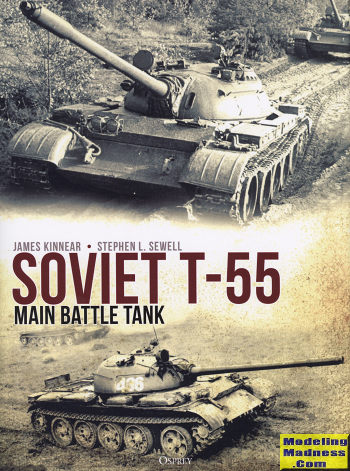 The T-55 was a
fairly natural progression of the previous T-54, in the same way that the M60
was a progression of the M48. It was obvious fairly early in the 1950s that the
T-44 would not be able to hold its own in the projected battle fields of Europe
so a new tank was required. This tank needed to have more armor and a bigger
gun. Thus, after the usual political infighting among the tank factories, the
T-55 was borne.
The T-55 was a
fairly natural progression of the previous T-54, in the same way that the M60
was a progression of the M48. It was obvious fairly early in the 1950s that the
T-44 would not be able to hold its own in the projected battle fields of Europe
so a new tank was required. This tank needed to have more armor and a bigger
gun. Thus, after the usual political infighting among the tank factories, the
T-55 was borne.
The major differences between it and the T-44 was a bit more
armor, a larger gun, and the inclusion of some sort of crew protection from
fallout from tactical nuclear devices. In upgraded tanks, gun stabilization was
added, first in the vertical and later in the horizontal as well. This allowed
the the tank to fire on the move (in theory anyway).
To say that the tank was a success would be a bit of an
understatement as it is considered by many to be the most produced tank of all
time. For sure it is one of the most exported with not only all Warsaw Pact, but
all Soviet-friendly nations receiving a goodly number of these tanks. It was
also build under license in Poland and Czechoslovakia with the Chinese reverse
engineering it as the Type 59. Even the Israelis operated nearly 200 of these
from those captured from the Egyptians during their conflicts with that nation.
As with most tanks, a variety of different variations were
produced. This included kits to allow it to ford deep water and pontoons to
allow it to cross rivers and lakes. There were engineering vehicles, bridge
layers, mine destruction vehicles and armored recovery vehicles to name just a
few of the many types.
While never used in combat in Europe, it was used widely in
the middle east and in other conflicts throughout the world. In battle it
generally ended up second best, not only due to fairly poor training, but also
that it faced more capable tanks. It was especially vulnerable against attack
helos and anti-tank weapons of all sorts. This led to all sorts of different
armor enhancements being used to prevent penetration of these weapons/rounds.
In this book, the authors have obviously done their research
(and not without considerable help in Russia according to the introduction to
the book). This includes not only the design of the tank but also the rather
convoluted politics of the time among designers. The full history of its
development along with the different variants and variations are all included.
Brief examples of its multiple war involvements is also included. What is
surprising is that this tank is still in use with some world military arms as of
this writing.
In all, it makes for the best history of the type I have
read. A book that I can quite easily recommend to you as well.
September 2019
Copyright ModelingMadness.com. All rights reserved.
For more on the complete line of Osprey books,
visit www.ospreypublishing.com .
If you would like your product reviewed fairly and quickly, please
contact
the editor or see other details in the Note to
Contributors.
 The T-55 was a
fairly natural progression of the previous T-54, in the same way that the M60
was a progression of the M48. It was obvious fairly early in the 1950s that the
T-44 would not be able to hold its own in the projected battle fields of Europe
so a new tank was required. This tank needed to have more armor and a bigger
gun. Thus, after the usual political infighting among the tank factories, the
T-55 was borne.
The T-55 was a
fairly natural progression of the previous T-54, in the same way that the M60
was a progression of the M48. It was obvious fairly early in the 1950s that the
T-44 would not be able to hold its own in the projected battle fields of Europe
so a new tank was required. This tank needed to have more armor and a bigger
gun. Thus, after the usual political infighting among the tank factories, the
T-55 was borne.